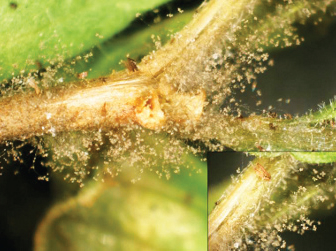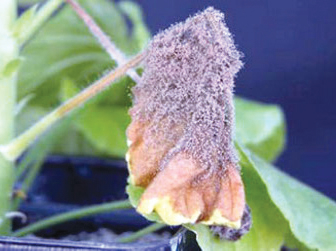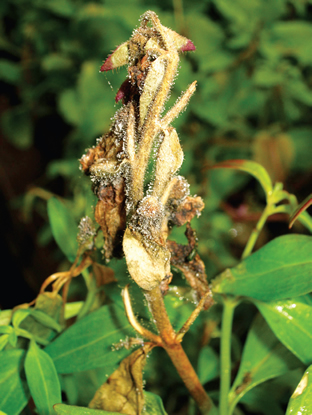 Listening to the continuity announcer, she announced weather forecast for the next five days as cloudy, cool and rainy weather conditions. These low light, humid conditions combined with a near full greenhouse floral crops meant Botrytis blight outbreaks. My crop was especially vulnerable now since they had a full flower canopy filled to the maximum allowable space.
Listening to the continuity announcer, she announced weather forecast for the next five days as cloudy, cool and rainy weather conditions. These low light, humid conditions combined with a near full greenhouse floral crops meant Botrytis blight outbreaks. My crop was especially vulnerable now since they had a full flower canopy filled to the maximum allowable space.
Immediately, my Production Manager called me, “we are in danger of contracting Botrytis”, he started. “Botrytis is a fungal disease that can cause leaf spots, petiole blighting and stem cankers on
our crop. It will produce large masses of “fuzzy looking” spores that are most often called “gray mold.” These spores or conidia will be spread on wind currents and can readily travel from infected to uninfected plants in that manner. The spores can survive for upwards of 21 to 24 days before they germinate on a plant”, he concluded.
 “Am listening”, I said after a short interval of silence. “I suggest cultural control practices that will reduce the conditions that favour Botrytis infections: reducing the relative humidity in the greenhouse below 85 percent; making sure plants do not remain wet for six or more hours in a 24-hour period; and if possible, heat and vent on mornings and evenings for at least a half-hour or more to reduce humidity thus removing the humid, warm air allowing for plant surfaces to dry”, he said.
“Am listening”, I said after a short interval of silence. “I suggest cultural control practices that will reduce the conditions that favour Botrytis infections: reducing the relative humidity in the greenhouse below 85 percent; making sure plants do not remain wet for six or more hours in a 24-hour period; and if possible, heat and vent on mornings and evenings for at least a half-hour or more to reduce humidity thus removing the humid, warm air allowing for plant surfaces to dry”, he said.
“ Do we have any seriously infected plants”, I asked. “Not of now”, he said. “However, if plants are seriously infected and need to be removed from the growing area, I will not just remove the plants and throw them on the compost pile out behind the greenhouse range as the spores can blow back into the facilities on wind currents.
 Instead, I will bag up infested plants where they were growing, seal the bags and remove them from the facilities, thus reducing the risk of spores dislodging and infecting other plants in the greenhouse. I will also use the same process when cleaning plants to remove dead foliage. I will bag it and remove the spent blooms or leaves as quick as possible so the spores are not released in a clean greenhouse” he concluded.
Instead, I will bag up infested plants where they were growing, seal the bags and remove them from the facilities, thus reducing the risk of spores dislodging and infecting other plants in the greenhouse. I will also use the same process when cleaning plants to remove dead foliage. I will bag it and remove the spent blooms or leaves as quick as possible so the spores are not released in a clean greenhouse” he concluded.


